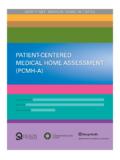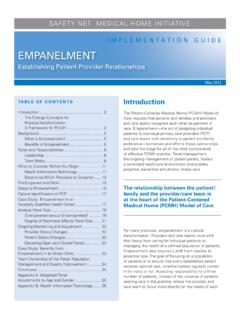Transcription of I M P L E M E N T A T I O N G U I D E I M P L E M E N T A ...
1 IMPLEMENTATION SAFETY NET MEDICAL HOME INITIATIVER educing Care Fragmentation in Primary CareIMPLEMENTATION GUIDECARE COORDINATIONMay 2013 TABLE OF CONTENTSI ntroduction ..1 The Change Concepts for Practice Transformation: A Framework for PCMH ..2 Care Management and care coordination : Understanding the Overlap and the Differences ..3 Reducing Care Fragmentation: A Toolkit for Coordinating Care ..5 Consequences of Fragmentation ..5 The care coordination Model ..8 Elements of Effective care coordination ..12 Care Transitions ..20 Case Tools and A: Health Information Technology ..40 This Implementation Guide begins with an introduction that defines care coordination and the recommended key changes for safety net practices, including a focus on behavioral health integration.
2 It is followed by Reducing Care Fragmentation, a toolkit that includes a detailed discussion of the four basic elements of effective referral or transition management. The toolkit s recommendations are exemplified in a series of case studies and through links to specific tools ( , job descriptions and staff training curricula).Introduction The complexity of modern medicine demands specialization, and high quality healthcare must ensure that patients receive care from those people and institutions best trained and equipped to provide a service, whether it be a surgical procedure, a medical evaluation, support for lifestyle change, or financial advice. As a consequence, care often involves referrals from provider to provider and transitions from one facility to another.
3 This complex system of care delivery can be dangerous, frustrating, and expensive if not managed well. Reducing the potentially deleterious effects of fragmentation is a central objective of the Patient-Centered Medical Home (PCMH) Model of Care. care coordination begins with the thoughtful identification of key service providers in the community followed by the the deliberate organization of patient care activities between two or more participants involved in a patient s care to facilitate the appropriate delivery of health care services. 1 care coordination is especially challenging in safety net practices because of: The complexity of many patients medical, social, and financial situations. The diversity of languages and cultures and the challenge of matching patients with providers that can meet their needs.
4 The difficulties of obtaining specialty services for uninsured or Medicaid patients in many safety net practices have valuable assets that if organized well can potentially ensure effective care coordination . For example, safety net practices have a rich knowledge of their community s assets and resources, and often have staff and outreach workers that can support patients outside of the GUIDECARE COORDINATIONT here is stronger evidence about the problems that occur when care isn t well coordinated than about the changes practices can make to prevent those problems. However, innovative practice systems, including some safety net practices, have begun to identify major changes practices can make to provide effective, efficient, and satisfying referrals and transitions.
5 This emerging evidence and experience show that effective care coordination programs, regardless of patient population, share four common design elements: assuming accountability for care coordination , providing patient support, developing relationships and agreements with key outside providers, and establishing connectivity that ensures appropriate information transfer. These four design elements are described in detail in Reducing Care Fragmentation: A Toolkit for Care Change Concepts for Practice Transformation: A Framework for PCMH Change concepts are general ideas used to stimulate specific, actionable steps that lead to improvement. The Safety Net Medical Home Initiative (SNMHI) established a framework for PCMH transformation to help guide practices through the transformation process.
6 The framework includes eight change concepts in four stages: Laying the Foundation: Engaged Leadership and Quality Improvement Strategy. Building Relationships: Empanelment and Continuous and Team-Based Healing Relationships. Changing Care Delivery: Organized, Evidence-Based Care and Patient-Centered Interactions. Reducing Barriers to Care: Enhanced Access and Care Change Concepts for Practice Transformation have been most extensively tested by the 65 safety net practices that participated in the SNMHI, but they are applicable to a wide range of primary care practice types. The Change Concepts have been adopted by a number of other improvement initiatives, reflecting their generalizability in primary care regardless of patient population or practice structure.
7 The Change Concepts were derived from reviews of the literature and also from discussions with leaders in primary care and quality improvement. They are supported by a comprehensive library of resources and tools that provide detailed descriptions and real examples of transformation strategies. These resources are free and publicly available. To learn more, see the Change Concepts for Practice Transformation. Message to ReadersPractices beginning the PCMH transformation journey often have questions about where and how to begin. We recommend that practices start with a self-assessment to understand their current level of medical homeness and identify opportunities for improvement. The SNMHI s self-assessment, the Patient-Centered Medical HomeAssessment (PCMH-A), is an interactive, self-scoring instrument that can be downloaded, completed, saved, and shared.
8 Readers are also encouraged to download additional care coordination materials: care coordination Executive Summary provides a concise description of the Change Concept, its role in PCMH transformation, and key implementation activities and actions. Webinars provide additional examples, tips, and success stories and highlight the best-practices of SNMHI sites and other leading practices. 3 IMPLEMENTATION GUIDECARE COORDINATIONKey Changes for Care CoordinationThe eight Change Concepts provide a framework for PCMH transformation. Each change concept includes multiple key changes. These provide a practice undertaking PCMH transformation with more specific ideas for improvement. Each practice must decide how to implement these key changes in light of its organizational structure and context.
9 The key changes for care coordination are: Link patients with community resources to facilitate referrals and respond to social service needs. Integrate behavioral health and specialty care into care delivery through co-location or referral protocols. Track and support patients when they obtain services outside the practice. Follow-up with patients within a few days of an emergency room visit or hospital discharge. Communicate test results and care plans to patients/families. Reducing Care Fragmentation will focus on two of the five key changes track and support patients and follow-up with patients and touch upon a third link patients with community resources. Behavioral integration will be addressed separately in a future SNMHI Implementation Management and care coordination : Understanding the Overlap and the Differences In this Guide, we make an important distinction between care coordination and care management.
10 On the one hand, we use care coordination interchangeably with referral or transition management, limiting its use to describe the essentially non-clinical but important functions such as providing information and logistical help to referred patients, ensuring timely and effective transfer of patient information, and tracking referrals and transitions to identify and potentially remedy glitches. But many patients are more severely ill, and require more intensive clinical management in addition to logistical and informational support. Care management refers to the more intensive care provided by nurses or other health workers to high-risk patients. It encompasses both referral/transition management and clinical services such as monitoring, self-management support, and medication review and adjustment.












